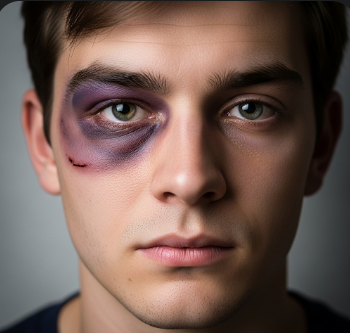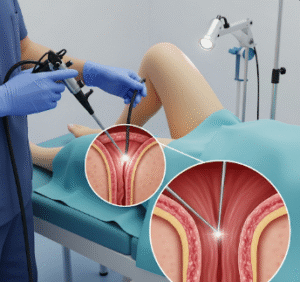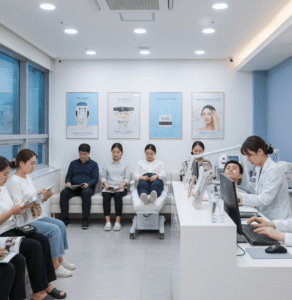Overview
A black eye, medically known as a periorbital hematoma, occurs when blood and fluid collect in the tissues surrounding the eye, usually following trauma to the face or head. It is characterized by discoloration, swelling, and bruising around the affected eye. While a black eye is often minor and self-limiting, it can occasionally indicate more serious injuries, including fractures, internal bleeding, or damage to the eye itself. In Korea, hospitals and specialized ophthalmology and emergency clinics provide comprehensive evaluation, imaging, and treatment to ensure proper healing and prevent complications.
Key Facts
▶ Prevalence: Common in sports injuries, accidents, falls, or physical altercations.
▶ Appearance: Bruising with purple, blue, or black discoloration around the eye.
▶ Duration: Typically heals within 1–2 weeks, depending on severity.
▶ Associated Symptoms: Swelling, tenderness, headache, or visual disturbances.
▶ Treatment Options in Korea: Cold and warm compresses, pain management, surgical intervention if necessary, and monitoring for eye or facial fractures.
What is a Black Eye?
A black eye occurs when small blood vessels around the eye break, allowing blood to pool under the skin.
▶ Minor Black Eye: Swelling and discoloration without vision impairment or structural damage.
▶ Severe Black Eye: May involve orbital fractures, lacerations, or eye injuries requiring medical attention.
▶ Associated Swelling: The area around the eye becomes tender, puffy, and discolored.
Note: Even if the eye itself is not injured, evaluation is important to rule out fractures, internal bleeding, or head trauma.
What Symptoms Are Related to a Black Eye?
▶ Discoloration: Purple, blue, or black bruising around the eye.
▶ Swelling: Puffy eyelids and surrounding tissues.
▶ Tenderness: Pain when touching the area.
▶ Headache: Often associated with facial trauma.
▶ Visual Disturbances: Blurred vision, double vision, or light sensitivity in some cases.
▶ Nasal or Facial Congestion: If associated with facial fractures.
▶ Redness in the Eye (Subconjunctival Hemorrhage): Small red spots in the white part of the eye.
▶ Difficulty Opening Eye: Due to swelling and discomfort.
What Causes / Possible Causes
Black eyes typically result from trauma or injury but may occasionally arise from other factors:
▶ Direct Trauma: Punches, falls, sports injuries, or accidents.
▶ Surgical Procedures: Facial or dental surgeries can sometimes cause bruising.
▶ Facial Fractures: Orbital or nasal fractures leading to periorbital bleeding.
▶ Allergic Reactions: Rarely, severe allergies may cause swelling and bruising.
▶ Medical Conditions: Blood clotting disorders or medications that affect coagulation (blood thinners).
▶ Sinus Infections: Severe sinus infections can sometimes contribute to discoloration under the eyes (rare).
Note: The cause, mechanism of injury, and associated symptoms help determine whether urgent medical evaluation is necessary.
When Should I See a Doctor?
▶ Severe Pain or Swelling: Persistent or worsening discomfort.
▶ Visual Changes: Blurred vision, double vision, or loss of vision.
▶ Recurrent or Spontaneous Bruising: Could indicate clotting disorders.
▶ Head Injury Symptoms: Nausea, vomiting, dizziness, or loss of consciousness.
▶ Associated Facial Fractures: Suspected broken nose, cheekbone, or orbital bone.
▶ Eye Injury: Foreign body sensation, bleeding inside the eye, or severe redness.
Tip: Even minor black eyes should be monitored for changes in vision or swelling, particularly in children or older adults.
Care and Treatment
Management of a black eye focuses on reducing swelling, controlling pain, and promoting healing:
▶ Cold Compress: Apply ice packs for the first 24–48 hours to reduce swelling and limit bruising.
▶ Elevate Head: Sleeping with the head elevated reduces fluid accumulation.
▶ Pain Management: Over-the-counter pain relievers like acetaminophen; avoid blood-thinning NSAIDs if bleeding risk is a concern.
▶ Warm Compress: After 48 hours, warm compresses can promote blood reabsorption and healing.
▶ Rest: Avoid strenuous activities that could worsen the injury.
▶ Observation: Monitor for changes in vision, swelling, or signs of infection.
▶ Avoid Rubbing the Eye: Prevents further tissue damage.
Treatment Options in Korea
Medical Evaluation:
▶ Ophthalmology or Emergency Consultation: To assess for eye injury or orbital fractures.
▶ Imaging: X-rays or CT scans for suspected facial fractures or internal bleeding.
▶ Laboratory Tests: Blood tests if clotting disorders are suspected.
Advanced Therapies:
▶ Surgical Intervention: Repair of orbital fractures, eyelid lacerations, or hematoma drainage if necessary.
▶ Medication: Prescription anti-inflammatory drugs or antibiotics for associated injuries or infections.
▶ Rehabilitation: Follow-up care for visual recovery or post-trauma facial swelling.
Rehabilitation & Support:
▶ Patient Education: Guidance on home care, signs to watch for, and protective measures.
▶ Follow-Up Care: Monitoring for healing progress and assessment of functional recovery.
▶ Specialist Clinics: Korean hospitals offer integrated care combining ophthalmology, emergency medicine, and maxillofacial expertise.
Outcome: With timely evaluation and proper management in Korea, most black eyes heal fully within 1–2 weeks, restoring normal appearance and function, while preventing complications such as vision impairment or permanent tissue damage.













